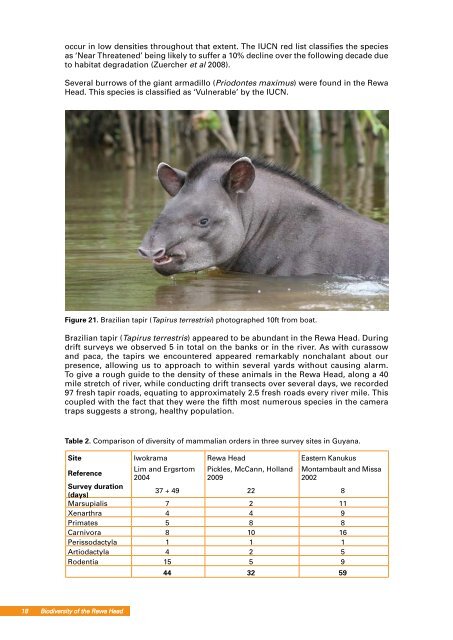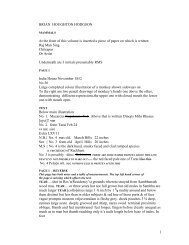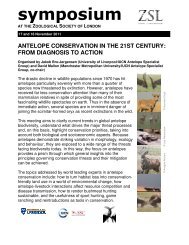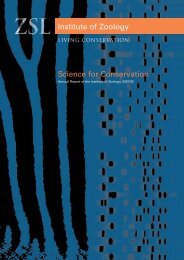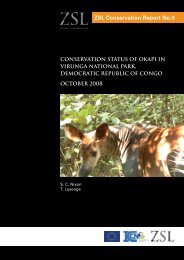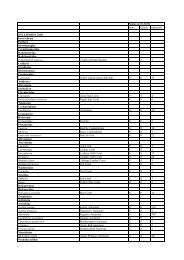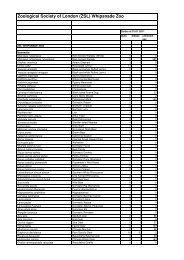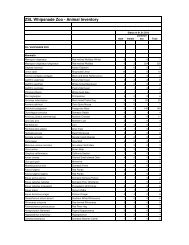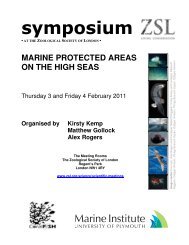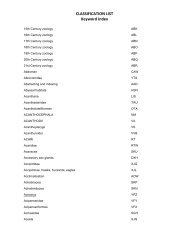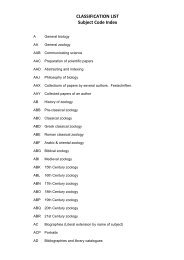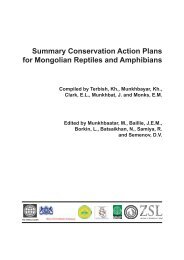Biodiversity of the Rewa Head B Zoological Society of London ...
Biodiversity of the Rewa Head B Zoological Society of London ...
Biodiversity of the Rewa Head B Zoological Society of London ...
You also want an ePaper? Increase the reach of your titles
YUMPU automatically turns print PDFs into web optimized ePapers that Google loves.
occur in low densities throughout that extent. The IUCN red list classifies <strong>the</strong> species<br />
as ‘Near Threatened’ being likely to suffer a 10% decline over <strong>the</strong> following decade due<br />
to habitat degradation (Zuercher et al 2008).<br />
Several burrows <strong>of</strong> <strong>the</strong> giant armadillo (Priodontes maximus) were found in <strong>the</strong> <strong>Rewa</strong><br />
<strong>Head</strong>. This species is classified as ‘Vulnerable’ by <strong>the</strong> IUCN.<br />
Figure 21. Brazilian tapir (Tapirus terrestrisi) photographed 10ft from boat.<br />
Brazilian tapir (Tapirus terrestris) appeared to be abundant in <strong>the</strong> <strong>Rewa</strong> <strong>Head</strong>. During<br />
drift surveys we observed 5 in total on <strong>the</strong> banks or in <strong>the</strong> river. As with curassow<br />
and paca, <strong>the</strong> tapirs we encountered appeared remarkably nonchalant about our<br />
presence, allowing us to approach to within several yards without causing alarm.<br />
To give a rough guide to <strong>the</strong> density <strong>of</strong> <strong>the</strong>se animals in <strong>the</strong> <strong>Rewa</strong> <strong>Head</strong>, along a 40<br />
mile stretch <strong>of</strong> river, while conducting drift transects over several days, we recorded<br />
97 fresh tapir roads, equating to approximately 2.5 fresh roads every river mile. This<br />
coupled with <strong>the</strong> fact that <strong>the</strong>y were <strong>the</strong> fifth most numerous species in <strong>the</strong> camera<br />
traps suggests a strong, healthy population.<br />
Table 2. Comparison <strong>of</strong> diversity <strong>of</strong> mammalian orders in three survey sites in Guyana.<br />
Site Iwokrama <strong>Rewa</strong> <strong>Head</strong> Eastern Kanukus<br />
Reference<br />
18 <strong>Biodiversity</strong> <strong>of</strong> <strong>the</strong> <strong>Rewa</strong> <strong>Head</strong><br />
Lim and Ergsrtom<br />
2004<br />
Pickles, McCann, Holland<br />
2009<br />
Montambault and Missa<br />
2002<br />
Survey duration<br />
(days)<br />
37 + 49 22 8<br />
Marsupialis 7 2 11<br />
Xenarthra 4 4 9<br />
Primates 5 8 8<br />
Carnivora 8 10 16<br />
Perissodactyla 1 1 1<br />
Artiodactyla 4 2 5<br />
Rodentia 15 5 9<br />
44 32 59


